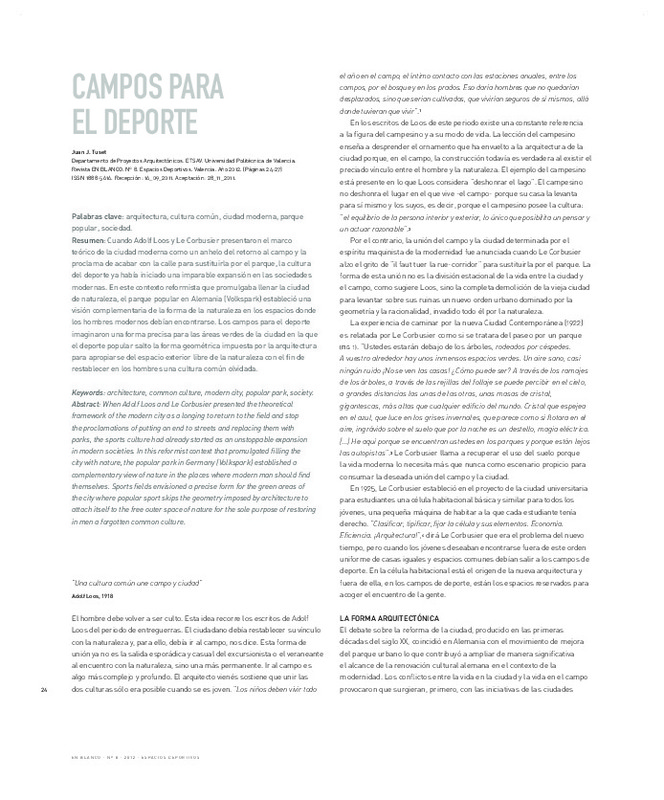JavaScript is disabled for your browser. Some features of this site may not work without it.
Buscar en RiuNet
Listar
Mi cuenta
Estadísticas
Ayuda RiuNet
Admin. UPV
Campos para el deporte
Mostrar el registro sencillo del ítem
Ficheros en el ítem
| dc.contributor.author | Tuset, Juan J.
|
es_ES |
| dc.date.accessioned | 2018-09-20T10:16:27Z | |
| dc.date.available | 2018-09-20T10:16:27Z | |
| dc.date.issued | 2012-04-29 | |
| dc.identifier.issn | 1888-5616 | |
| dc.identifier.uri | http://hdl.handle.net/10251/107820 | |
| dc.description.abstract | [EN] When Adolf Loos and Le Corbusier presented the theoretical framework of the modern city as a longing to return to the fi eld and stop the proclamations of putting an end to streets and replacing them with parks, the sports culture had already started as an unstoppable expansion in modern societies. In this reformist context that promulgated fi lling the city with nature, the popular park in Germany (Volkspark) established a complementary view of nature in the places where modern man should find themselves. Sports fi elds envisioned a precise form for the green areas of the city where popular sport skips the geometry imposed by architecture to attach itself to the free outer space of nature for the sole purpose of restoring in men a forgotten common culture. | es_ES |
| dc.description.abstract | [ES] Cuando Adolf Loos y Le Corbusier presentaron el marco teórico de la ciudad moderna como un anhelo del retorno al campo y la proclama de acabar con la calle para sustituirla por el parque, la cultura del deporte ya había iniciado una imparable expansión en las sociedades modernas. En este contexto reformista que promulgaba llenar la ciudad de naturaleza, el parque popular en Alemania (Volkspark) estableció una visión complementaria de la forma de la naturaleza en los espacios donde los hombres modernos debían encontrarse. Los campos para el deporte imaginaron una forma precisa para las áreas verdes de la ciudad en la que el deporte popular salto la forma geométrica impuesta por la arquitectura para apropiarse del espacio exterior libre de la naturaleza con el fin de restablecer en los hombres una cultura común olvidada. | es_ES |
| dc.language | Español | es_ES |
| dc.publisher | Universitat Politècnica de València | |
| dc.relation.ispartof | EN BLANCO. Revista de Arquitectura | |
| dc.rights | Reconocimiento - No comercial (by-nc) | es_ES |
| dc.subject | Arquitectura | es_ES |
| dc.subject | Cultura común | es_ES |
| dc.subject | Ciudad moderna | es_ES |
| dc.subject | Parque popular | es_ES |
| dc.subject | Sociedad | es_ES |
| dc.subject | Architecture | es_ES |
| dc.subject | Common culture | es_ES |
| dc.subject | Modern city | es_ES |
| dc.subject | Popular park | es_ES |
| dc.subject | Society | es_ES |
| dc.title | Campos para el deporte | es_ES |
| dc.title.alternative | Fields for sport | es_ES |
| dc.type | Artículo | es_ES |
| dc.date.updated | 2018-09-20T08:09:26Z | |
| dc.identifier.doi | 10.4995/eb.2012.6897 | |
| dc.rights.accessRights | Abierto | es_ES |
| dc.description.bibliographicCitation | Tuset, JJ. (2012). Campos para el deporte. EN BLANCO. Revista de Arquitectura. 4(8):24-27. https://doi.org/10.4995/eb.2012.6897 | es_ES |
| dc.description.accrualMethod | SWORD | es_ES |
| dc.relation.publisherversion | https://doi.org/10.4995/eb.2012.6897 | es_ES |
| dc.description.upvformatpinicio | 24 | es_ES |
| dc.description.upvformatpfin | 27 | es_ES |
| dc.type.version | info:eu-repo/semantics/publishedVersion | es_ES |
| dc.description.volume | 4 | |
| dc.description.issue | 8 | |
| dc.identifier.eissn | 2445-1215 |








